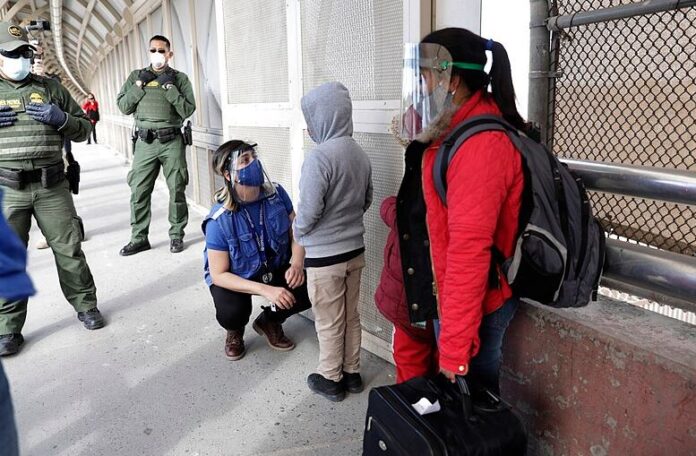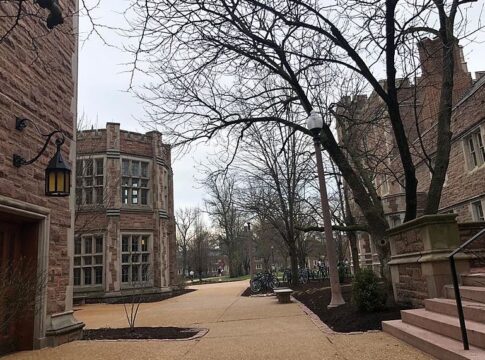By Erin Chew
Please Note: To protect the identity of the Chinese migrants interviewed, names have been changed.
27-old Miss Liu, started her journey by train from Ecuador to Mexico before arriving in San Diego. For her, San Diego is not her final destination as her plan was to head to Chicago where her second cousin’s family lives.
“I saw how well migrants do in America from Hollywood movies and TV series, and I feel life there is easier than my present life that I had in China. I saw videos of Chinese students in America sharing their interesting lives, and so that is why I made this journey”, Miss Liu discussed in a recent interview with AsAmNews.
Miss Liu was born in a small town, over three hundred miles outside of Beijing, and having no college qualifications, found it hard to make ends meet. It was her cousin’s family who encouraged her to come over to America and move to Chicago where she would work in the family’s takeout restaurant.
LATEST STORIES
“I had no influential connections, nor does my family have a lot of money to send me to America as an international student, so I took the risk and crossed the border this way. My second cousin and his family live in Chicago, so that is where I aim to live and start my new life”.
Chinese migrants are the fastest growing group coming across the border from Mexico to America, in search of better opportunities and life in America. In an ABC 10 San Diego report from February this year (which AsAmNews reported on), there has been a 500% increase of Chinese migrants being detained near the San Diego border. In 2023, U.S. Customs and Border Protection (CBP) detained thirty-seven thousand Chinese nationals trying to cross the border into America. This is fifty times the numbers of 2021 and 2022.
The question is why? What are the reasons for this increasingly growing group? Interestingly, a large number of those wanting to cross the border are young, single Chinese individuals. Many of them in their prime and should be at the peak of the careers.
Mr. Zhou, is twenty-five years old and was born and raised in a village located in Runxi Township, which is approximately around one hundred and forty or so miles outside of Chongqing- a major city located in southwestern China. Mr. Zhou studied bookkeeping in a small local college and found it impossible to get a job in his field when he decided to move to Chongqing after graduation.
“Initially, my goal was to move to the big city of Chongqing and get a job as a bookkeeper in a small to medium sized company. I don’t have huge ambitions, but I wanted to live comfortably and be able to send money back to my parents in my hometown. When I got to Chongqing, I couldn’t even get an interview for bookkeeping jobs I applied for because I wasn’t a citizen of Chongqing and I didn’t graduate from a top college”.
Mr. Zhou ended up working menial jobs cleaning office buildings and delivering food through those food delivery apps. He said that it was difficult to make ends meet and he had to live in a shared apartment with six to seven other people. For Mr. Zhou, the systems in Mainland China benefit those who come from above middle class to wealthy families, those who graduated from big name colleges and those who are considered citizens of major cities.
“I have lost hope in my home country. We are a country that is growing fast economically, but that only benefits some groups. For people like me, who was born and raised in a small rural village, and who wasn’t able to get into a top college, we are invisible in Chinese society and we fall behind because of who and where we were born,” Zhou stated.
Crossing the border from Mexico into San Diego is a dangerous and arduous journey. Some fly into Mexico City from another country and start their journey to cross from there (walking, catching a bus, train etc), whilst others risk more of their safety and come by boat and start their crossing journeys off various coasts around Mexico. At the end of last month, a boat carrying Chinese migrants capsized off the coast of the Mexican southern state of Oaxaca, killing eight with only one Chinese man surviving. This situation is still currently under investigation, but it demonstrates the lengths Chinese migrants who make this journey are willing to take.
In addition, the difficulties continue even when the border is crossed. With the recent closure of the San Diego Migrant Welcome Center, all migrants, including the Chinese migrants are picked up by Customs and Border Protection (CBP) at the border, get dropped off at transit centers of Iris Street Trolley Station and at Old Town Trolley Station in San Diego. From there the migrants make their way to the airport and travel to their final destination.
Jose Ng, an immigration rights advocate from San Francisco based not for profit – Chinese for Affirmative Action (CAA), traveled to these San Diego trolley/transit stations with his colleagues to meet some of these Chinese migrants and understand the situation at hand.
Ng says that the Chinese migrants make this journey with the goal of seeking asylum and they feel the only way to do so, is to cross the border. There are no special migration visa schemes for them to apply for and they are not wealthy enough to come into America as an international student or for work/business reasons.
“From my observations and understanding is that Chinese migrants are finding their way into America from crossing the border from Mexico border cities. They come into America without any papers for an authorized entry so their aim is to apply for asylum, and to do so they must have a reason in seeking asylum. They may cite reasons of economic crisis happening in China due to the impacts of the pandemic and/or human rights reasons (being persecuted in China for being LGBT, religious and cultural reasons etc). These reasons are no different from any other migrant coming to America from across the border”, Ng discussed with AsAmNews.
For Mr. Zhou, the value of the American dollar against the Chinese yuan, makes it more worthwhile. He feels hopeful that he will be able to apply for asylum in the near future, start a new life and create a better one for his family back home.
“The value of the American money is way higher than the Chinese money, so by default, no matter what job I do, I will earn more than I did back in Chongqing doing the same menial jobs. I am resourceful and can do any job, so I will try my best to earn as much as I can to afford a lawyer to help change my status to become legal”.
For Chinese migrants like Mr. Zhou and Miss Liu, San Diego is not their primary destination. It is merely a transit point to go to other cities in America, where the Chinese community is larger and more well established, such as San Francisco, Chicago, New York City, New Jersey, Los Angeles etc. The group of Chinese migrants interviewed by AsAmNews, were heading to New Jersey, Chicago and Los Angeles.
“I don’t know much about San Diego, except that it is a border city. I think for most Chinese, San Diego is not where they plan to live. Because I have family in Chicago, it is better that I go live and work with them. I can speak basic English, but it is not good enough to live and work in areas where there is no Mandarin speaking community”, Miss Liu expressed.
The process migrants must go through once they surrender themself/themselves to the CBP at the border is a complex one. Under U.S. law and international treaties, CBP must allow migrants who say they’re afraid to return home to submit their claims in the asylum process. They can ask for asylum at any port of entry along the U.S. border. Before they can walk through the gate into the U.S. side, migrants are processed and then receive papers and a notice to appear at the immigration court to determine whether they can legally stay in U.S. or not.
However, before they even reach this point, the journey is difficult. Ng mentioned that the general route for Chinese migrants planning on crossing the border is through countries they can travel to without a visa – via Hong Kong to Thailand, from Thailand to Turkey and then from Turkey to Ecuador and enter Mexico from there.
After they enter America, the migrants still face deportation because they have not been granted asylum.
“Our concerns are that when they have to report into CBP (Customs & Border Protection) and/or immigration court, they will say things, give their real names and identities which could become a consequence later on if they are ordered to be deported back to Mainland China. The other concerns are that there is hostility towards people of Chinese origins and those who are coming in seeking asylum. This comes from both inside the Chinese community in America and outside. I feel fear for them and cringe when I see photos of Chinese migrants in the media or if names are mentioned – these are things we are worried about”, Ng mentioned.
Despite all these risks and dangers, this has not stopped the influx of Chinese migrants coming to America from the Mexico borders. For Chinese migrants Mr. Zhou and Miss Liu, it is all about seeking a better life financially and career wise (as a hope for their future) and they took a gamble of potentially being deported for this.
However, for Mr. Ping, who is twenty-three years old, and came from a small city outside Xian, it is his identity and lifestyle which has pushed him to make this journey. Mr. Ping is a gay man, and has been involved in LGBTQ advocacy in Mainland China, which is essentially an underground movement. He left as he didn’t want to implicate his own parents and family members back home and hopes he can meet someone in America with mutual affection who he can be with, marry and start his life in America with. Mr. Ping plans to settle down with some childhood friends who now live and work in Los Angeles.
“This is my one and only opportunity to make a life for myself. I am a gay man and have been involved with advocacy work in China for the LGBTIQ movement. This movement is not out and proud like they are in America and I worry for my parents and my younger sister who could get implicated by the Chinese authorities due to the advocacy work I have been involved in. It is still seen as illegal to be out and proud LGBTIQ in China. I was unable to live free, and I am betting on all the dangers and risks to be in a country where I can be who I want to be”, Mr. Ping discussed.
The current situation at the border for Chinese migrants is a challenging situation. This influx was unexpected by migrant support groups, and there doesn’t exist many services specifically catered to support the Chinese migrants. Migrant support groups which service the San Diego – Tijuana border have provided food, water and basic necessities to the Chinese migrants, but there needs to be more coordinated support particularly in language and collecting data in understanding where and why this influx is occurring. CAA is doing what they can to meet with local migrant support groups and collecting data, but more help is needed.
AsAmNews is published by the non-profit, Asian American Media Inc. Follow us on Facebook, X, Instagram, TikTok and YouTube. Please consider making a tax-deductible donation to support our efforts to produce diverse content about the AAPI communities. We are supported in part by funding provided by the State of California, administered by the California State Library in partnership with the California Department of Social Services and the California Commission on Asian and Pacific Islander American Affairs as part of the Stop the Hate program. To report a hate incident or hate crime and get support, go to CA vs Hate.








